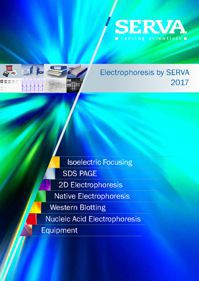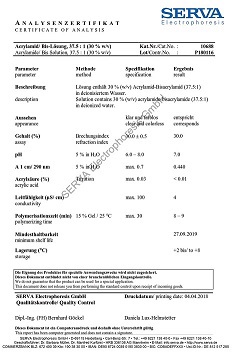Synperonic® F 68
Synperonic F-68 is a polyoxyethylene-polyoxypropylene copolymer with important biotechnological and medical applications.
The non-ionic surfactant Synperonic F-68 can be effectively used in cell culture to protect microorganisms, animal and plant cells against mechanical damage. Corresponding effects have been observed in the cultivation of cells from insects, yeasts, fibroblasts and melano¬mas. In addition, the surfactant enhances the growth of animal and plant cells by increasing the nutrient uptake.
Synperonic F-68 is a valuable supplement in plant cell culture for exploitation of membrane effects in genetic manipulations involving protoplasts.
Due to its excellent emulsifying properties, Synperonic F68 is very well suited for investigations of water insoluble active ingredients in biotechnology and pharmacology.
Emulsions of perfluorochemicals with Synperonic F-68 are of considerable medical impor-tance: they are being evaluated as adjuncts to enhance oxygenation of ischaemic tissues. isolated organs and tumors.
Synperonic is a registered trademark of CRODA International Plc.
Synonyms: Pluronic PE 6800, Pluronic F-68, Poloxamer 188
CAS registry number : [9003-11-6]
Relative molecular mass (Mr): appox. 8300
Classification: non-ionic surfactant
Literature specification :
• Critical micellar concentration (CMC) : 0.04 mM
• Hydrophilic-lipophilic balance (HLB) : 29
Bibliography
Cell Culture Techniques
King, A.T., Lowe, K.C. a. Mulligan, B.J. (1988) Microbial cell responses to a non-ionic surfactant. Il. Effects as assessed by fluorescein diacetate uptake. Biotechnol. Lett. 10, 873-8.
Murhammer, D.W. a. Goochee, C.F. (1988) Scale-up of insect cell cultures: protective effects of Pluronic F-68. Bio/Technology 6, 1411-15, 1418.
Bentley, P.K., Gates, R.M.C., Lowe, K. C., De Pomerai, D.I. a. Walker J.A.L. (1989) In vitro cellular responses to a non-ionic surfactant, Pluronic F-68. Biotechnol. Lett. 11, 111-4.
Handa-Corrigan, A., Emery, A.N. a. Spier, R.E. (1989) Effect of gas-liquid interfaces on the growth of suspended mammalian cells: mechanisms of cell damage by bubbles. Enzyme Microb. Technol. 11, 230-5.
King, A.T., Davey, M.R., Mulligan, B.J. a. Lowe, K. C. (1990) Effects of Pluronic F-68 on plant cells in suspension culture. Biotechnol. Lett. 12, 29-32.
Murhammer, D. W. a. Goochee, C.F. (1990) Structural features of non-ionic polyglycol polymer molecules responsible for the protective effect in sparged animal cell bioreactors. Biotechnol. Prog. 6, 142-8.
Zhang, Z. et al. (1992) Effect of Pluronic F-68 on the mechanical properties of mammalian cells. Enzyme Microb. Technol. 14, 980-3.
Khatun, A. et al. (1993) Effects of Pluronic F-68 on shoot regeneration from cultured jute cotyledons and on growth of transformed roots. Plant Cell, Tissue Organ Cult. 34, 133-40.
Laouar, L. et al. (1996) Yeast responses to nonionic surfactants. Enzyme Microb. Technol. 18, 433-8.
Schlaeger, E.-J. (1996) Medium design for insect cell culture. Cytotechnology 20, 57-70.
Härkönen, P. et al. (2003) Sex hormone metabolism in prostata cancer cells during transition to an androgen.independent state. J. Clin. Endocrin. Metabol. 88, 705-12
Pharmaceutical Applications
Riess, J.G., Greiner, J., Le Blanc, M., Lin, Y.S., Manfredi, A., Pace, S.,Varescon, C. a.
Zarif,L. (1988) New polyhydroxylated perfluoroalkylated surfactants derived from sugars
and related compounds. Applications to the formulation of oxygen carriers for in vivo use.
Actual. Chim. Ther. 15, 247-51.
Xiao, N., Lu, X., Chen, H., Yang, Z. a. Tian, K. (1989) Effect of fluorocarbon blood substitute on neutrophil phagocytic function. Zhongguo Yaoli Xuebao 10, 537-9.
Katakam, M. et al. (1995) Effect of surfactants on the physical stability of recombinant human growth hormone. J. Pharm. Sci. 84, 713-6.
Calvo, P. et al. (1996) Improved ocular bioavailability of indomethacin by novel ocular drug carriers. J. Pharm. Pharmacol. 48, 1147-52.
Duclairoir, C. et al. (2002) -Tocopherol encapsulation and in vitro release from wheat gliadin nanoparticles. J. Microencapsulation 19, 53-60.
Further Applications
Holloway, P.J. et al. (1992) Effects of some non-ionic polyoxyethylene surfactants on uptake of ethirimol and diclobutrazol from suspension formulations applied to wheat leaves. Pesticide Science 34, 109-18.
Moghimi, S.M. a. Murray, J.C. (1996) Poloxamer-188 revisited: a potentially valuable immune modulator. J. Natl. Cancer Inst. 88, 766-8.
Edwards, C.M. et al. (1997) Effects of a novel perfluorocarbon emulsion on neutrophil chemiluminescence in human whole blood in vitro. Artif. Cells Blood Substit. Immobil. Biotechnol. 25,255-60.
Denizli, A. et al. (2000) Preparation and characterization of magnetic polymethylmethacrylate microbeads carrying ethylene diamine for removal of Cu(II), Cd(II), Pb(II), Hg(II) from aqueous solutions. J. Appl. Polym. Sci. 78, 81-9.
Tanyolac, D. a. Ozdural, A.R. (2001) BSA adsorption onto magnetic polyvinylbutyral microbeads. J. Appl. Polym. Sci. 80, 707-15.
De Cupere, V.M. et al. (2003) Nanoscale organization of collagen and mixed collagen-Pluronic adsorbed layers. Langmuir 19, 6957-67.
Jung-Hua Steven Kuo (2003) Effect of Pluronic-block copolymers on the reduction of serum-mediated inhibition of gene transfer of polyethyleneimine-DNA complexes. Biotechnol. Appl. Biochem.37, 267-71.






